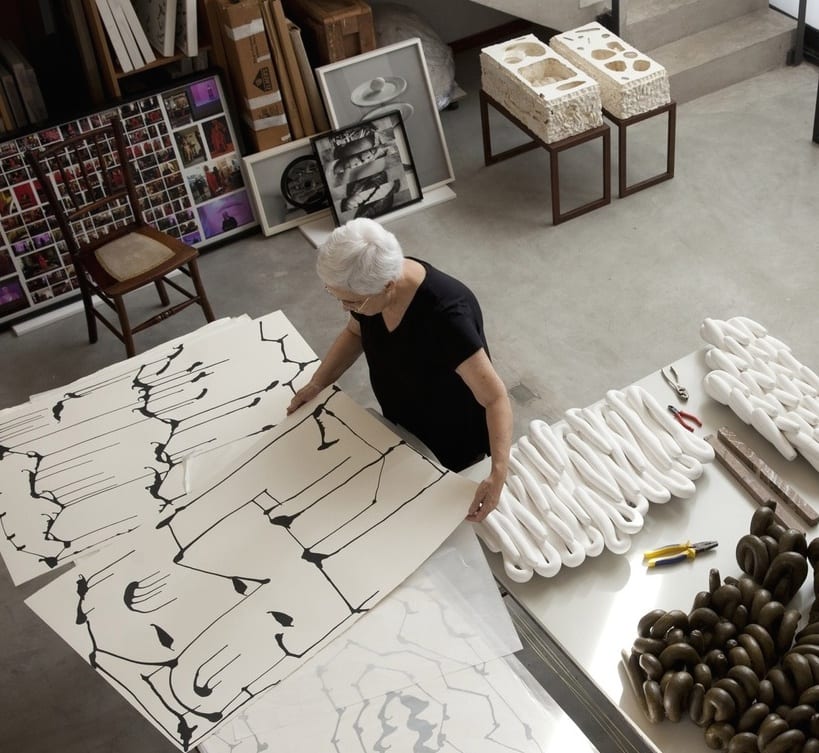Anna Maria Maiolino is one of the most significant artists working in Brazil today and one of most important in exploring the matrix between clay, ceramics and molds. Since 1989 her primary medium (but not only) has been clay, ceramics and molds. This post regards her solo exhibition at Hauser & Wirth, New York (May 7 – June 21, 2014), and is one of five posts from CFile surveying a career spanning five decades and a diversity of disciplines and mediums, ranging from drawing, sculpture, and artist books to video and performance. The second post is an interview that is also published in this issue and gives meaningful context to many of the ideas in this exhibition. Do read both, Maiolino’s voice has a richness and depth that is mesmerizing.
Maiolino’s multidisciplinary practice has consistently explored the viscerality of embodied experience – often obliquely through fragmentation and abstraction – and engaged the human body’s processes as analogs for both the making of art and the making of modernity. As an immigrant coming of age in politically unstable Brazil, Maiolino has perfected a dialogue between opposite yet complementary categories in a practice that dissolves dichotomies of inner and outer, self and other. Hers is an art in search of a new language for the liminal realm of daily human existence.
Maiolino’s early experiments in the 1960s connected her to important movements in Brazilian art history, shadowed by the turmoil and governance of military repression: Neo-Concrete, New Figuration, New Objectivity. Maiolino took part in the radical reconfiguring of the art object – and thus the art institution and the artist – during this period. Along with Lygia Pape, Lygia Clark, and Hélio Oiticica, Maioliono participated in the 1967 exhibition, New Brazilian Objectivity, which symbolized a cultural shift in previous constructivist traditions and established a new vision for the production of art in Brazil.
After living in New York from 1968 to 1971, she returned to Brazil and devoted herself to drawing as a means of self-expression. Working to further define her identity as both an individual and an artist, she initiated a new series of works on paper that gave emphasis to the gesture, the action, and the process of making.
Maiolino has worked primarily in clay since 1989, noting that her first encounter with the material provoked a fire from within: “When we lay our hands on that wet mass of clay, a whole cosmic vision appears with all the archetypes of creation,” she once said. Maiolino relates the act of molding clay to the act of writing and the mobility of drawing; molding involves a language of hand gestures, a type of serial aesthetic exploration conducted through the acts of kneading, rolling, stretching, and cutting. In Untitled (1993 / 2013) from the Cobrinhas (Little Snakes) series, Maiolino employs basic forms to create coils, repeatedly made and added to the body of her sculpture. Through these works and the processes that rendered them, the artist reaches toward what she has described as “the big and transcendental things: the search for totality and the infinite through repetition and seriality.”
In the three freestanding sculptures São 21 (They are 21) (2013), São 25 (They are 25) (2013), and Mais que Um (More than One) (2013) from the Preposições (Prepositions) series, Maiolino incorporates the practice of Raku ceramics. The flamed surface of each piece retains traces of its firing process, and for Maiolino, sustains its organic materiality and relation to the earth and the moving body that shaped it. Employing techniques of modeling, molding, and casting, Maiolino engages a dialogue of opposites: the positive, the negative, and “in-between space.” Evocative of century old fossils or the membranes of a coral reef, works from her series Entre o Dentro e o Fora (Between Inside and Outside) are filled by cavities and holes. Maiolino associates these molds with the now-absent objects that once occupied the negative space left behind.

Anna Maria Maiolino, Untitled, from Entre o Dentro e o Fora (Between Inside Outside) series, 2012
Anna Maria Maiolino’s work grows in spiral succession. Neither linear nor chronological, the ongoing, open-ended nature of her practice enables her to work freely across discipline and media, while marinating a coherent conceptual thread through the entirety of her body of work.
Born in Italy in 1942, Anna Maria Maiolio lives and works in São Paulo, Brazil. Recent solo exhibitions include The Matrix 252, University of California, Berkeley Art Museum, Berkeley , CA and Pacific Film Archive (2014) and Affections, Museu de Arte de São Paulo (MASP), Brazil. In 2010, the major retrospective Anna Maria Maiolino opened at the Antoni Tàpies Foundation, Barcelona, Spain and traveled to the Galician Center for Contemporary Art, Santiago de Compostela, Spain (2011) and Malmö Kunsthalle, Malmo, Sweden (2011). Major solo exhibitions also include Continuum, Camden Arts Centre, London, England (2010); Order and Subjectivity, Pharos Center for Contemporary Art, Nicosia, Cyprus (2007); Territories of Immanence, Miami Art Center, Miami, Fla (2006); Many, Maiolino’s first retrospective in Brazil hosted by the Pinacoteca do Estado de São Paulo (2005); and Vida Afora/A Life Line, The Drawing Center, New York (2001). In recent years, Maiolino’s work has garnered critical international recognition at dOCUMENTA 13, Kassel, Germany (2012); the Sydney Biennale, Sydney, Australia (2008) and numerous editions of the São Paulo Biennale.
Featured image: Anna Maria Maiolino in the studio. Photographs by Everton Ballardin.
Any thoughts about this post? Share yours in the comment box below.

Anna Maria Maiolino, Untitled, from In-Moto (In-Motion) series, 2012

Anna Maria Maiolino, Untitled, from Interações (Interactions) series, 2011

Anna Maria Maiolino, Untitled, from Vestígios (Vestiges) series, 2010

Anna Maria Maiolino, Preposições (Prepositions) series, 2013


Installation view.





Add your valued opinion to this post.